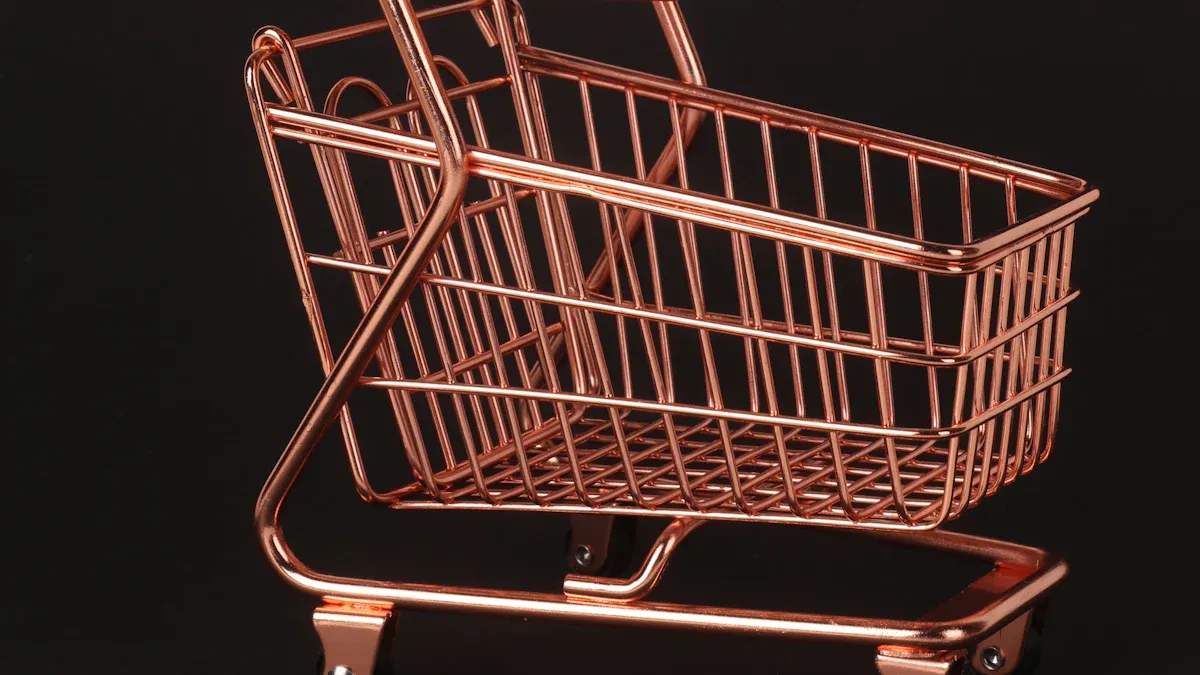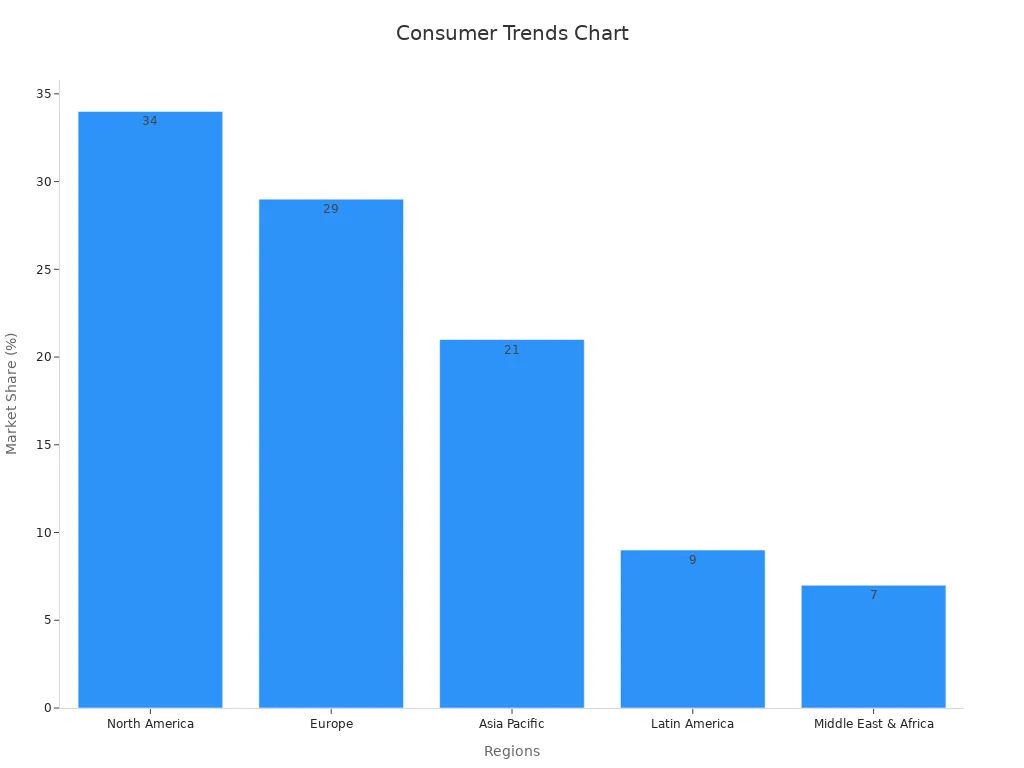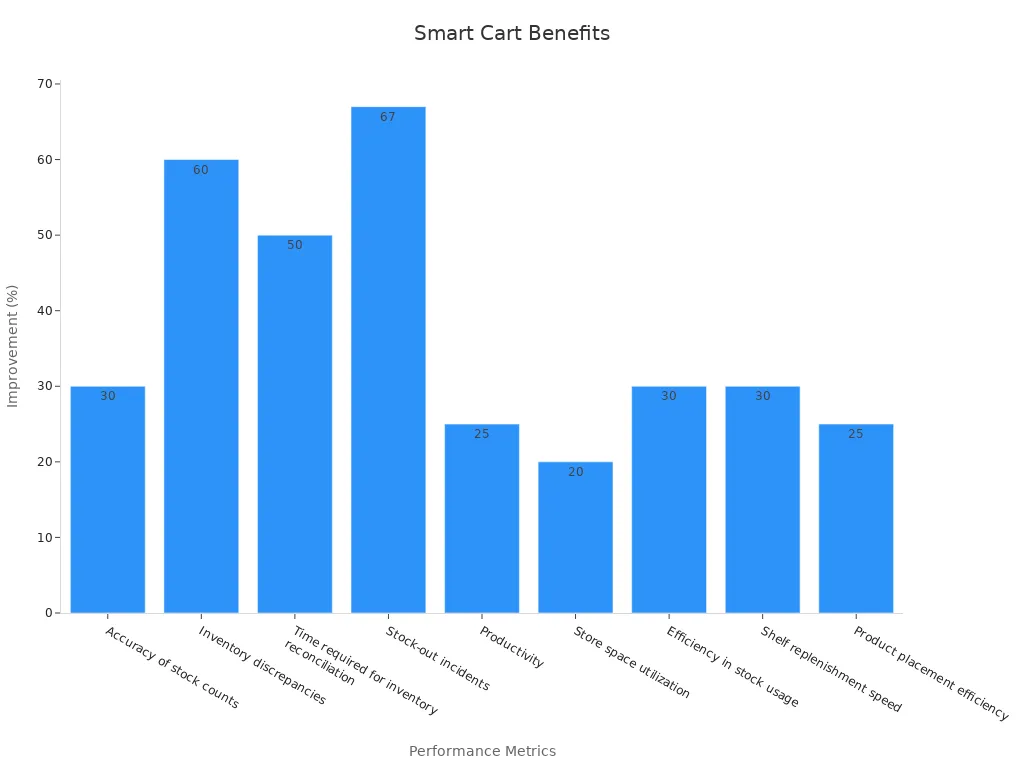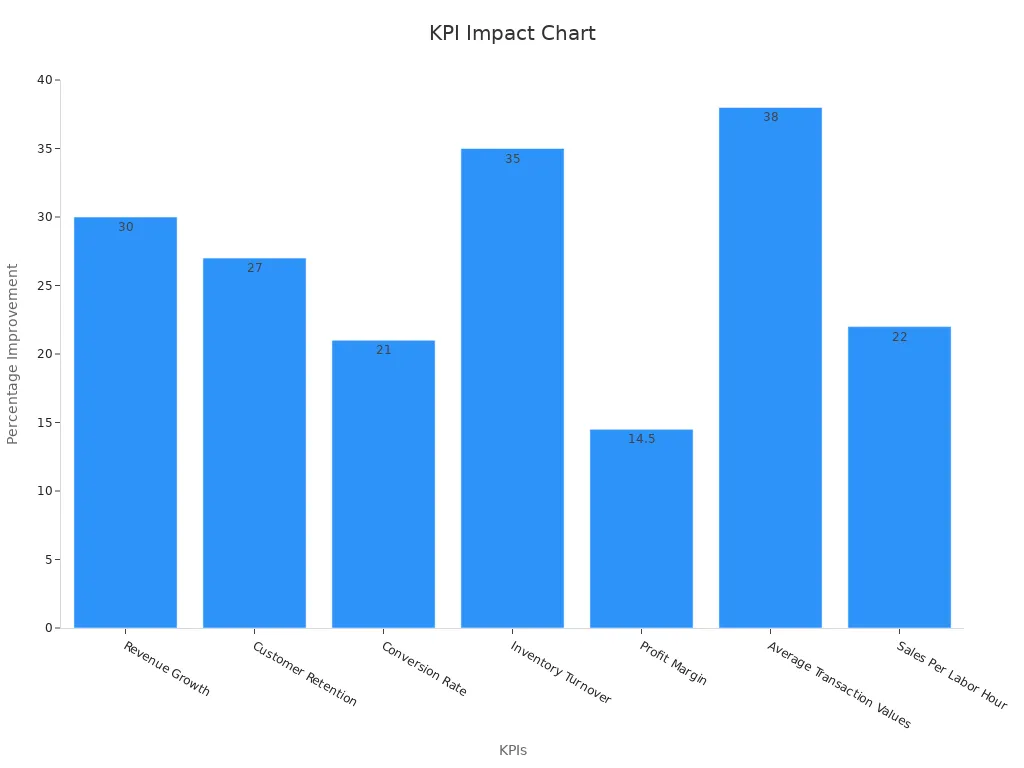Shopping Karts: Evolution, Types, and Smart Technology Integration

Shopping karts help you carry items as you shop in stores. Over time, shopping karts have changed a lot. You now see stronger materials and smart features that make your trips easier. When you understand how shopping karts improve, you notice how they shape your shopping experience.
Knowing these changes helps you see why stores and shoppers both benefit from better design and new technology.
Key Takeaways
Shopping karts have evolved from simple metal frames to smart, connected tools that make shopping easier and faster.
Different types of karts, like metal, plastic, hybrid, specialty, and compact designs, meet various store and shopper needs.
Smart shopping karts use technology like AI, sensors, and IoT to offer real-time billing, product suggestions, and faster checkout.
Both shoppers and retailers benefit from smart karts through improved convenience, personalized experiences, and better inventory management.
Future shopping karts will include more innovations like voice assistance, augmented reality, and eco-friendly materials to enhance your shopping trip.
Evolution of Shopping Karts

Invention
You might be surprised to learn that shopping karts started with a simple idea. In 1937, Sylvan Goldman, a grocery store owner, invented the first shopping kart. He wanted to help shoppers carry more items without getting tired. His design looked like a folding chair with wheels and baskets. This invention changed how people shopped. You could now buy more in one trip and move around the store with ease.
Milestones
Over the years, shopping karts have seen many improvements. In the 1980s, stores added swivel wheels, making it easier for you to turn corners and move in tight spaces. Retailers also began using stronger materials like stainless steel and plastic hybrids. These changes made karts last longer and feel lighter. Today, you see smart karts with sensors, barcode scanners, and even touchscreens. Big stores like Amazon and Walmart use these features to help you check out faster and track your items as you shop.
Evidence Type | Description | Supporting Details |
|---|---|---|
Historical Sales Data | Market size valuation and growth projections indicating adoption of innovations over time | Market valued at USD 796.06 million in 2024, projected to reach USD 5,187.12 million by 2032, CAGR 26.40% |
Consumer Adoption Trends | Retailers implementing smart and ergonomic carts reflecting consumer acceptance and demand for innovative features | Amazon Dash Cart with AI and sensor fusion; Walmart and Kroger adopting self-checkout and digital payment carts |
Technological Advancements | Integration of RFID, barcode readers, AI, and touchscreen displays in carts | Smart carts enabling self-checkout, real-time product tracking, and personalized shopping experiences |
Consumer Needs
You expect shopping karts to make your trip easier and faster. As more people shop in cities, stores need karts that fit small aisles and hold many items. Shoppers want karts that are easy to push, clean, and safe. Retailers now use smart technology to meet these needs. For example, IoT and AI help track what you buy and suggest products you might like. Stores also use recycled materials to make karts more eco-friendly. The demand for convenience, e-commerce, and sustainability drives these changes.
Statistic Category | Data / Insight |
|---|---|
Market Size 2024 | |
Forecast CAGR (2026-2033) | 11.5% |
Market Size by 2033 | USD 14.5 Billion |
Regional Market Share (2023) | North America: 34%, Europe: 29%, Asia Pacific: 21%, Latin America: 9%, Middle East & Africa: 7% |
Fastest Growing Region | Asia Pacific (8.5% CAGR) |
Market Share by Material (2023) | Stainless Steel: 38%, Metal/Wire: 33%, Plastic Hybrid: 18%, Others: 11% |
Fastest Growing Segment | Plastic Hybrid Shopping Carts (6.2% CAGR) |
Key Applications | Supermarkets (55% revenue share), Shopping Malls (30%) |
Consumer Trends Driving Design | Convenience demand, e-commerce rise, urbanization, rising disposable incomes |
Innovations Influenced | Smart carts with IoT, self-checkout, AI personalization, sustainability-focused designs |

Types of Shopping Karts
Metal Karts
You often see metal karts in large supermarkets. These karts use strong materials like stainless steel. Metal karts can carry heavy loads and last for years. However, they feel heavy when you push them. Over time, metal can rust, which means stores spend more money on repairs. Many stores still use metal karts because they cost less at first.
Plastic and Hybrid
Plastic and hybrid karts have become more popular in recent years. You notice that plastic karts feel lighter and move more easily. Hybrid karts combine a metal frame with plastic parts. This design gives you the strength of metal and the lightness of plastic. Retailers choose these karts to reduce maintenance costs and improve your shopping experience. They also resist rust and last longer in wet conditions. Many stores invest more money at first for these karts, especially when they add smart features like RFID or self-checkout.
Metal Carts | Plastic Carts | Hybrid Carts | |
|---|---|---|---|
Durability | High durability and load capacity | Moderate durability | Metal frame provides durability |
Weight | Heavy | Lightweight | Lighter than metal due to plastic components |
Maneuverability | Less maneuverable due to weight | Easier to maneuver | Improved maneuverability |
Corrosion Resistance | Susceptible to corrosion | Resistant to corrosion | Plastic parts resist corrosion |
Environmental Impact | Traditional, less eco-friendly | Concerns about plastic waste | Designed for sustainability |
Initial Investment | Lower initial cost | Higher initial cost possible | Higher initial cost, especially with tech |
Maintenance Costs | Higher due to corrosion and repairs | Lower maintenance | Reduced maintenance compared to metal |
Operational Challenges | Heaviness and corrosion | Environmental concerns | Balances pros and cons of metal and plastic |
Tip: Many retailers now lease or buy durable plastic hybrid karts to balance cost, function, and sustainability.
Specialty Karts
Specialty karts serve unique needs in different stores. You might find small, deep baskets for single-person households or carts with extra safety features for children. Supermarkets and shopping malls often use smart karts with digital screens or scanners. Market research shows that these specialized karts help stores meet your needs for safety and convenience. The demand for these karts keeps growing, especially in North America, Europe, and Asia Pacific. Stores design these karts to fit their space and customer base.
Compact Designs
Compact karts work best in stores with narrow aisles or limited space. You see these karts in city markets or convenience stores. They are easy to push and store. Compact designs help you shop quickly and avoid crowding. Retailers use these karts to make shopping smoother for you, especially when you only need a few items. As more people shop in cities, compact karts become even more important.
Smart Technology in Shopping Karts

Smart Features
You see smart shopping carts in many modern stores. These carts use advanced technology to make your shopping experience smoother and faster. You find features like barcode scanners, RFID tags, cameras, and weight sensors. Some carts have interactive displays that show your shopping list or help you find products. You can scan items as you shop, which means you skip long lines at self-checkout stations. Stores like Amazon use Dash Carts with sensors and computer vision to identify what you put in your cart. Carrefour uses RFID-enabled carts for quick inventory checks and personalized offers.
Aspect | Evidence |
|---|---|
AI, ML, IoT, RFID, weight sensors, cameras, interactive displays enabling self-scanning, automatic checkout, real-time stock management, personalized promotions, contactless shopping | |
Market Examples | Amazon Dash Cart (sensors, computer vision), Carrefour RFID-enabled carts |
Market Segmentation | Types: RFID Shopping Cart, Sensor-Based Shopping Cart; Applications: Supermarkets, Hypermarkets, Retail Chains |
Market Drivers | Increased demand for contactless shopping post-pandemic, operational efficiency, reduced labor dependency, enhanced customer experience through AI and IoT |
Regional Growth | North America fastest-growing region due to early adoption, retailer automation, consumer familiarity with digital interfaces and loyalty apps |
Challenges | High initial capital, technical failures, data privacy regulations (e.g., CCPA) |
Opportunities | Personalized marketing, consumer insights, AR overlays, eco-friendly practices |
Smart shopping carts use these features to help you shop faster and more easily. You get real-time updates on your bill, and the cart can even suggest products based on your past purchases. This technology helps stores manage inventory and gives you a more personalized shopping experience.
AI and IoT
You benefit from AI and IoT every time you use a smart shopping cart. AI-powered applications recognize items using cameras and sensors. The cart can scan barcodes or use computer vision to identify products. IoT connects your cart to the store’s network, so you get real-time updates and the store tracks inventory automatically. You see your total bill update as you add items, which makes self-checkout much easier.
The system uses deep learning models for fast and accurate item recognition.
A Raspberry Pi with a camera captures video, sending data to a main server for quick processing.
The cart supports multiple payment methods, so you can pay in the way you like.
Stores use cloud computing to handle lots of carts at once, making the system scalable for big supermarkets.
You notice that these smart carts bridge the gap between physical and digital shopping. They connect your in-store trip with online features, like digital coupons or shopping lists. This integration helps you move smoothly between online and in-store shopping.
Shopper Benefits
Smart shopping carts make your shopping experience better in many ways. You get real-time billing updates, so you always know how much you spend. The cart can suggest healthier options or show you where to find products. You can check out right at the cart, skipping self-checkout stations and long lines. AI analyzes your shopping habits to give you personalized shopping experiences, such as special deals or loyalty rewards.
A recent study with 950 shoppers found that interactive smart carts increase satisfaction, make shopping more effective, and encourage you to return to the same store. You feel more in control and enjoy a smoother trip. The cart’s touchscreen can help you create a shopping list, check inventory, and even guide you through the store.
Tip: If you want a faster trip, use a smart cart to skip self-checkout stations and get real-time help as you shop.
Retailer Benefits
Retailers gain many advantages from smart shopping carts. These carts track inventory in real time, so stores know exactly what is on the shelves. Automated alerts tell staff when to restock, which reduces empty shelves and lost sales. Smart carts also collect data about what you buy, helping stores plan better and reduce waste.
Metric | Improvement |
|---|---|
Accuracy of stock counts | improved by 30% |
Inventory discrepancies | reduced by 60% |
Time for inventory reconciliation | decreased by 50% |
Stock-out incidents | reduced by 67% |
Productivity | increased by 25% |
Store space utilization | improved by 20% |
Efficiency in stock usage | enhanced by 30% |
Shelf replenishment speed | increased by 30% |
Product placement efficiency | improved by 25% |

Retailers also use dashboards to see sales trends and inventory levels. This helps them make better decisions and improve store operations. Smart carts reduce the need for manual work, lower costs, and help prevent theft and errors. With better data, stores can offer you more personalized shopping experiences and keep shelves stocked.
Challenges
You may notice some challenges with smart shopping carts. Data privacy is a big concern, since these carts collect information about your purchases. Stores must follow strict rules to protect your data and get your consent. The cost of smart carts is high, especially with new tariffs on imported parts like cameras and sensors. This makes it harder for some stores to invest in the latest technology.
Regional rules differ, so stores must adjust their systems for each country.
Integrating many technologies, like RFID, AI, and IoT, can be complex and costly.
Some shoppers find self-checkout and smart carts hard to use, especially older adults or those not used to digital devices.
Shrinkage from theft and errors still affects stores, so security features are important.
Stores must balance the cost of smart carts with your need for low prices and convenience.
Note: 74% of customers worry about problems with self-checkout, but 59% say they would use it more if the technology improved.
Smart shopping carts play a key role in automated retail environments. They help stores run more smoothly and give you a better shopping experience. As technology improves, you will see even more benefits from these smart systems.
Future Trends
Innovation
You will see many new innovations shaping the future of smart shopping carts. Retailers now use AI to give you personalized shopping experiences. For example, some carts can scan, weigh, and let you pay right at the cart. IoT helps stores track inventory and manage products more efficiently. Contactless payments make your trip faster and safer. Data analytics lets stores understand your habits and show you ads that match your interests. Many carts now use eco-friendly materials to help the environment. You can also use mobile apps to create shopping lists or find items in the store. Voice assistance and augmented reality features are starting to appear, making your trip even easier. Modular components allow stores to upgrade carts without replacing them. As more stores open in cities around the world, these trends will continue to grow.
Innovation Type | Description | Market Example / Impact |
|---|---|---|
AI Integration | Personalized shopping experiences with real-time recommendations | Coles' AI-powered smart trolleys allowing scanning, weighing, and payment directly on the trolley |
IoT Connectivity | Inventory tracking and efficient store operations | Enables seamless store management |
Contactless Payments | Quick, hygienic transactions aligned with consumer preferences | Widely adopted for convenience and safety |
Data Analytics | Insights into consumer behavior for targeted marketing | Supports personalized ads, e.g., Instacart's Caper Carts displaying tailored ads |
Eco-Friendly Designs | Use of sustainable materials to meet environmental standards | Growing focus on sustainability in product design |
Mobile App Integration | Features like shopping lists and store navigation | Enhances shopper convenience |
Voice Assistance | Hands-free operation through voice-activated features | Improves accessibility and ease of use |
Augmented Reality | Product information display and virtual try-ons | Emerging feature to enrich shopping experience |
Modular Components | Easy upgrades and maintenance reducing long-term costs | Supports adaptability and longevity of smart carts |
Global Expansion | Adoption driven by urbanization and retail growth in emerging markets | Market growth fueled by expanding retail sectors globally |
Research shows that the smart shopping cart market will grow from $1.72 billion in 2024 to $5.35 billion by 2029. This rapid growth comes from AI, self-checkout, and checkout-free shopping. Retailers like Albertsons and Veeve already use carts that scan items, weigh produce, and connect to loyalty programs. These changes help you shop faster and make your trip more enjoyable.
Shopping Experience
You will notice big improvements in your shopping experience as technology advances. AI agents and virtual assistants will help you find products and suggest new ones. Stores will use robots and drones to keep shelves stocked and deliver items quickly. Live shopping events will mix entertainment with shopping, giving you more ways to learn about products. Many stores will focus on making your trip fun and memorable, not just about buying things.
Note: Physical stores remain important. By 2028, 72% of US retail sales will still happen in stores, showing that people value in-person shopping.
Retailers use pilot programs to test new technology before rolling it out. This helps them fix problems early and improve the self-checkout process. When stores use advanced carts and connect their systems, they see better results:
KPI/Metric | Improvement/Impact Description | Percentage/Value |
|---|---|---|
Revenue Growth | Increase through data-driven strategies | |
Customer Retention | Improvement via personalization | 27% |
Conversion Rate | Increase through real-time POS insights | 21% |
Inventory Turnover | Faster turnover with POS-optimized ordering | 35% |
Profit Margin | Enhancement through data-driven pricing | 14.5% |
Average Transaction Values | Higher values with omnichannel integration | 38% |
Sales Per Labor Hour | Improvement via workforce optimization | 22% |

You will see more mobile commerce, social shopping, and live shopping events. By 2024, mobile commerce sales will reach $558 billion. Social commerce will hit $1.2 trillion by 2025. These trends show that your shopping experience will become more connected and interactive. Self-checkout will keep improving, making your trips faster and easier. As stores blend online and in-person features, you will enjoy a seamless and engaging experience every time you shop.
You have seen shopping karts change from simple metal frames to smart, connected tools. Today, artificial intelligence, connectivity, and sustainability shape new designs and features. Stores use bar code and RFID technology, automatic checkout, and self-weighing carts in many retail settings. Companies now build modular platforms and offer subscription services to meet your needs.
The mix of technology, new rules, and what you expect as a shopper drives growth in smart shopping karts.
66% of grocery executives focus on margin growth, 56% want bigger basket sizes, and 50% value personalized experiences.
47% see smart carts as a top upgrade, and 40% are exploring them now.
85% believe in-cart ads matter, but only 36% use them.
100% agree that data from smart carts helps improve stores.
You can expect even more changes in the future. Think about how these innovations will shape your next shopping trip and the role of new ideas in retail.
FAQ
What makes a shopping kart “smart”?
A smart shopping kart uses technology like sensors, cameras, and displays. You can scan items, see your total, and check out faster. These karts help you shop more easily and give stores better ways to track products.
How do smart shopping karts improve my shopping experience?
You get real-time updates on your bill. The kart can suggest products or help you find items. You can check out right at the kart, which saves you time and makes shopping smoother.
Are smart shopping karts safe for my personal data?
Stores use strong security to protect your information. You should always check the store’s privacy policy. Most smart karts only collect data to help you shop and improve grocery supply chains.
Can I use smart shopping karts in every store?
Not every store has smart karts yet. You will find them mostly in large supermarkets or stores that focus on new technology. More stores plan to add them as they become more popular.
What happens if a smart shopping kart stops working?
If your smart kart has a problem, you can ask a store worker for help. Many stores have backup systems or regular karts ready. You will not lose your shopping progress because most systems save your information.
See Also
Smart Technology Is Transforming Electronics Vending In Retail
Vending Machines Progress From Simple Snacks To Smart Tech
AI Tools Revolutionize The Way Online Stores Are Managed
The Future Belongs To Stores Powered By Artificial Intelligence
